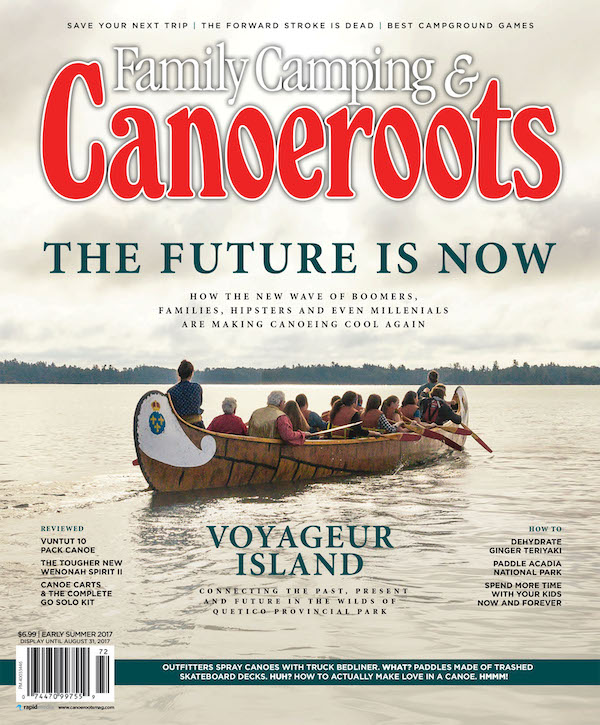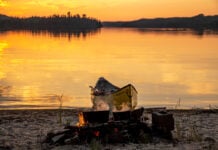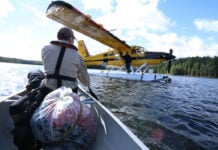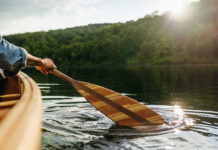I found my first canoe at the dump. It was a prospector design, made of fiberglass, had three keels and no company logo on it—just a roadrunner sticker pasted on the bow. I brought her home and patched her up. The research for my first two paddling guidebooks was done in that canoe. Her name was Gertrude.
I eventually improved my canoe collection and bought a second-hand boat—also a prospector, and also made of fiberglass. I paddled it solo down the full 426 kilometres of the Missinaibi River. I was in my mid-twenties and knew little about running whitewater except what I had learned from watching Bill Mason’s National Film Board films over and over again. He too liked to paddle a prospector. Maybe that’s why I preferred that design. Or maybe it’s why I like cute bubbly brunettes that look like Bailey Quarters from WKRP in Cincinnati. The sophisticated Jennifer Marlowe played by Loni Anderson may be nice to take to a dinner party, but she wouldn’t be as fun or as practical for me in the long run.
Put in simple terms, the prospector is not perfect at anything, but it’s moderately good at everything. In my opinion, it’s the best all-around canoe design. If I could only own one canoe, then it makes good sense to make it a prospector. I’m also guessing that’s why actual prospectors chose to use it.
The shape of a prospector is symmetrical, meaning both ends are the same shape. This allows me to paddle tandem but it can easily be switched to paddle solo. I merely sit in the front seat, trim the boat by shifting ballast and then paddle stern first.
The prospector is good for short day-trips but also for my extended time exploring the wilderness. In fact, it has even better control when loaded with gear. It’s deep, wide and has a substantial arch in the bottom designed to carry heavy loads and deal with large waves on lakes and in rapids. The boat, however, has lots of rocker for maneuverability. When heeled over solo-ing, both ends rise proudly out of the water.
I upgraded to Royalex for my third canoe, also a prospector. I used it to write A Paddler’s Guide to Rivers of Ontario and Quebec. I was by then a little more skilled at whitewater and still young enough not to be overly concerned about the extra weight of the canoe. By the time I started writing A Paddler’s Guide to Algonquin and A Paddler’s Guide to Ontario’s Lost Canoe Routes, I moved on to a Kevlar canoe—a prospector. It weighed in at a sexy 38 pounds. I was getting older, my body getting weaker and the portages longer.
The Prospector was originally developed by Chestnut Canoe Company of Fredericton, New Brunswick in 1923. Though Chestnut Canoe Company closed their doors in 1979, their molds lived on. A good assortment of companies are out there still making the prospector design, some closer to the original than others. My favorite over the years has been Nova Craft Canoes’ Prospector 16’.
Loyalty has swayed a couple times. Variety is the spice of life after all. I have a Cronje design and a Bob Special. They’re sitting on the canoe racks in my backyard, getting wet mostly from the rain. Gertrude however still sees plenty of water. I’ve patched her up a few more times, even painted her red. Must be the Bill Mason influence. He preferred a red canoe, a red prospector canoe.— Kevin Callan
Kevin Callan is the author of 16 books, including the bestselling, The Happy Camper and Wilderness Pleasures: A Practical Guide to Camping Bliss. He is still presenting across North America and has been a key speaker at all major canoe events. Butt End first appeared in Canoeroots magazine 16 years ago. Kevin lives in Peterborough, Ontario.

Subscribe to Paddling Magazine and get 25 years of digital magazine archives including our legacy titles: Rapid, Adventure Kayak and Canoeroots.








